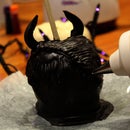Introduction: MLAB | LASERCUT SPEAR INSPIRED BY OKOYE
Did you know that the Dora Milaje, the self-described all-female 'Seal Team Six' in the Black Panther film, means 'the Adored Ones'? In our laboratory, we especially adore Okoye, the leader of the Dora Milaje.
Follow these simple steps to create your own Spear similar to the one branded by Okoye when vanquishing her enemies during the climatic fight scenes in the film using Tinkercad!
Hint: If you need a little inspiration before you get started....
Check out the mLab Episode II: 'It's Hard for a Good Man to Be King.
#WakandaForever
Step 1: Let's Get Started
In this Step-by-Step, we will show you how to make a 3D model of a Spear inspired by the character Okoye of the Dora Milaje from the Black Panther film. In order to create our 3D model, we will use the software, Tinkercad. Tinkercad is an online 3D design or CAD software that allows for you to transform your ideas into 3D models simply using your computer. As an added bonus, it's also free to use!
Now, if the term "CAD" sounds unfamiliar to you, don’t fear.
CAD stands for Computer-Aided Design. It is a type of software that allows for us to build 3D objects using our computer. Once we are finished with our Tinkercad model, we can export the model to a 3D Printer, a machine that uses materials such as plastic in order to print physical objects or even a cutting machine like a Laser Cutter, a machine that uses lasers to cut objects out of materials like cardboard and wood.
If you don't have access to a 3D Printer or Cutting Machine, you can also order a 3D print from Tinkercad or share a snapshot of your design with family and friends via Social Media. Regardless of what you decide to do with your CAD Model, the most important step is to get started. So...Let's Get Started!
Quick Tips for Setting Up You Tinkercad Workplane!
(These Tips are Optional, But if You are New to Tinkercad, Please Read!)
Edit Grid: Make sure that you go to the lower right corner of your Workplane and 'Edit Grid' in order to change the ‘Units’ to Inches (this is optional, but will make your life so much easier).
In addition, if you are using a 3D Printer or Cutting Machine, ensure your Workplane is the same size of your Machine's Work Bed. For Example, we are using the Epilog Mini Laser Cutter, so we will adjust our Grid to be a Height of 12 inches and Width of 24 inches.
Now...Let’s begin with exploring the ‘Basic Shapes’ on the right-hand side of your Tinkercad window.
Step 2: Let's Explore the Basic Shapes and Controls!
When you are getting started with anything new, especially software, it's sometimes worthwhile to explore and get a feel for the environment.
Let's start by selecting a 'Shape' from the 'Basic Shapes' Toolbar on the Right-Hand-Side of your window and dragging the shape onto your Workplane.

In our case, we selected a yellow 'Pyramid' and started playing around with its 'Dimensions'. Use the tiny white/black boxes around the selected 'Shape' to control the - Length, Width, and Height. Use the various black arrows around the selected 'Shape' to control the - Rotation.
Now, let's explore a few other 'Basic Shapes' that we will need in order to create our Spear;
Pyramid | Cylinder | Torus.
Tip: If you are concerned about the yellow color; Don't Panic!
We can change the color of the shape, can you figure out how?
Hint: Look at the 'Shape' Menu above your Workplane and the 'Solid' Feature.
Step 3: Make the Head of the Spear
Now that we have a little bit of experience with Tinkercad, let's get started with our 'Basic Shape'.
Before we can get started, let's clear our Workplace of any shapes or models in order to begin creating the head of our Spear on a clean Workplane.
Hint: While we will list the dimensions or measurements we used in order to create our version of Okoye's Spear for the Mini Epilog Laser Cutter, please do not feel that you have to replicate every step exactly. Remember, the exciting part about using a CAD Software such as Tinkercad is that you can make anything your heart desires. Simply use the following as suggestions for designing your Spear.

Part A:
- Select a 'Pyramid' from our 'Basic Shapes' Toolbar and bring it to our Workplane.
- Rotate, using the black double-ended arrow above the selected Pyramid, 90 degrees counter-clockwise (or the opposite way a clock would typically operate).
- Ensure the Pyramid's peak is lying parallel to your Workplane.
- Adjust to the desired Height of the Pyramid
- In the above example, our adjusted Height = 0.25 inches
- Change to the desired Length and Width of the Pyramid, ensuring the Pyramid maintains its overall shape.
- In the above example, our adjusted Length = 3.00 inches and adjusted Width = 1.25 inches
Part B:
- Use the Duplicate tool to duplicate the Pyramid
- At this moment, you should have (2) identical Pyramids on your Workplane.
- Rotate the duplicate Pyramid, using the black double-ended arrow on the Workplane, 180 degrees.
- In the above example, the Pyramids should mirror each other on the Workplane.
- Adjust to the desired Height of the duplicate Pyramid
- In the above example, our adjusted Height = 1.00 inches.
- Select both Pyramids - Use the Align tool to align them along their midpoints.
- Hint: On your keyboard, hold down CTRL +A (this selects all the shapes on the Workplane). Then, click the middle Black Dot along the 'Length' and 'Width' of the 'Selected Shapes' (this aligns all the shapes at their midpoint).
- Use the Group tool to combine the duplicate Pyramid and the Original Pyramid.
- Feel free to change the color!!
- In the above example, we adjusted our color from yellow to white.
Step 4: Make the Body for the Spear
Bravo! We have the first part of our Crown, the head of the Spear, Done!
Now start on the body of the Spear, which allows for the Spear to be easy to wield for Okoye in battle.

Part A:
- Select a 'Cone' from our 'Basic Shapes' Toolbar and bring it to our Workplane.
- Rotate, using the black double-ended arrow above the selected Cone, 90 degrees counter-clockwise (or the opposite way a clock would typically operate).
- Ensure the Cone's peak is lying flat on to your Workplane.
- Adjust to the desired Height of the Cone.
- In the above example, our adjusted Height = 0.25 inches
- Change to the desired Length and Width of the Cone, ensuring the Cone maintains its overall shape.
- In the above example, our adjusted Length = 3.00 inches
- In the above example, our adjusted Width = 0.5 inches
Part B:
- Select a 'Cylinder' from our 'Basic Shapes' Toolbar and bring it to our Workplane.
- Rotate, using the black double-ended arrow above the selected Cylinder, 90 degrees counter-clockwise (or the opposite way a clock would typically operate).
- Ensure the Cylinder's peak is lying parallel to your Workplane.
- Adjust to the desired Height of the Cylinder.
- In the above example, our adjusted Height = 0.25 inches
- Change to the desired Length and Width of the Cylinder, ensuring the Cylinder maintains its overall shape.
- In the above example, our adjusted Length = 1.75 inches
- In the above example, our adjusted Width = 0.5 inches
Now, it's time to make the handle for our Spear...
Step 5: Make the Grips for the Spear
Kudos! We are almost done!
Next, we need to create a handle for Okoye to use in order to make sure she doesn't develop any blisters while wielding her Spear.

Part A:
- Select a 'Torus' from our 'Basic Shapes' Toolbar and bring it to our Workplane.
- Rotate, using the black double-ended arrow above the selected Torus, 90 degrees counter-clockwise.
- Ensure the Torus is lying flat on your Workplane.
- Drag the Torus onto the base of your Spear (i.e. your Cylinder)
- Adjust to the desired Height of the Torus.
- In the above example, our adjusted Height = 0.25 inches
- Change to the desired Length and Width of the Cone, ensuring the Cone maintains its overall shape.
- In the above example, our adjusted Length = 1.5 inches
- In the above example, our adjusted Width = 0.65 inches
Part B:
- Use the Duplicate tool in order to create the desired number of Torus'
- In the above example, in order to make our desired grip, we used (7) Torus'
- Use the Align tool in order to ensure the Torus' are aligned with the Shapes on the Workplane
- Select all of the Torus' and Group in order to complete your Grip for the Spear
Now, the moment, we've been waiting for...let's see how it all comes together.
Step 6: Tips and Tricks to Customize Your Spear
There is a reason that the Dora Milaje are not only referred to as the 'Adored Ones' but those who are also dressed to kill. Therefore, having your own unique style is highly important to the Dora Milaje, especially Okoye. Hence, don't forget to customize your Spear to represent the Dora Milaje within you.
As you have seen so far, Tinkercad allows for you to make quite advanced CAD Models using a variety of Basic Shapes and techniques. For example, you can easily change the color of your Spear or add any other customization that speaks to you.
For a little inspiration, look at the customization we did with our Spear!

Now, go ahead and play around with our Customized 3D Spear above. Use your mouse or trackpad to move, zoom, and rotate the model. Hint: You can also use the control buttons on the top left corner of the screen. Have Fun!
Don't forget to share snapshots of your creations with us on Social Media using the Hashtags - #MakeAnything #BlackPanther #Mbadika.
Step 7: Export Spear to the Laser Cutter (Bonus)
If you have access to a Laser Cutter (or any other type of Cutting Machine);
Congratulations! You can make your Spear CAD Model into reality.
On Tinkercad, you can go to the upper Right Hand Corner and Export your CAD Model as a .SVG File which you can upload to the Laser Cutter or Cutting Machine Software which corresponds to your specific Machine.
If .SVG sounds a like an alien format, don't panic just yet. SVG (Scaled Vector Graphics) files are a very popular file format for 2D or CAD Models and its similar to exporting a Document as a Microsoft Word (.doc) or PDF format (.pdf). Once you upload the .SVG File to your specific software, the software will transform your CAD model into a language that machines, in particular 2D Cutting Machines, can understand.
So, in order to recap:
- .SVG = Language for 2D Cutting Machine Software
- In our case, we used Inkscape, which allows for you to upload .SVG files and convert the file format that corresponds to your specific Cutting Machine.

Participated in the
Epilog Challenge 9













